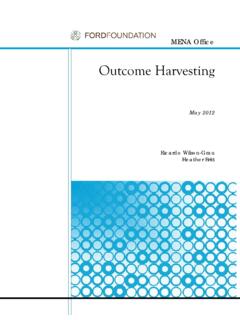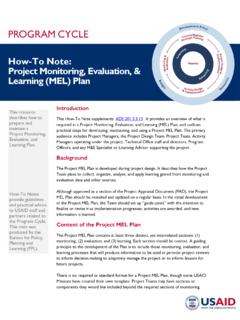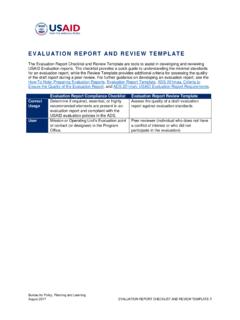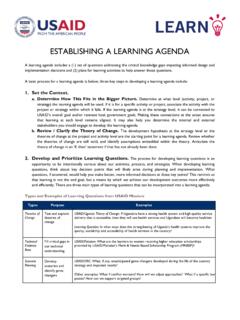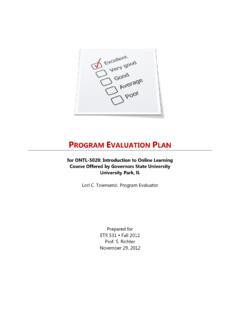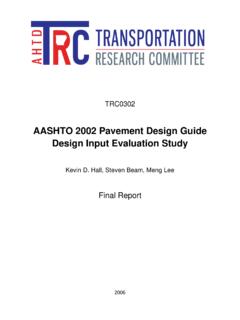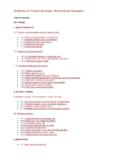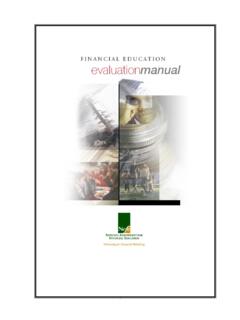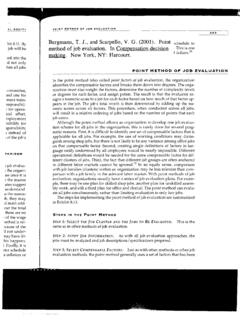Transcription of THE EVALUATION DESIGN MATRIX: TEMPLATES - USAID …
1 Bureau for Policy, Planning and Learning July 2015 THE EVALUATION DESIGN MATRIX: TEMPLATES -1 E V A L U A T I O N R E S O U R C E THE EVALUATION DESIGN MATRIX: TEMPLATES The EVALUATION DESIGN matrix is an essential tool for planning and organizing an EVALUATION . It is simply a table with one row for each EVALUATION question and columns that address EVALUATION DESIGN issues, such as data collection methods, data sources, analysis methods, criteria for comparisons, etc. The DESIGN matrix links each EVALUATION question to the means for answering that question.
2 There is no single format for a DESIGN matrix, but a number of example TEMPLATES are provided below. When to use an EVALUATION DESIGN Matrix? USAID recommends that the Statement of Work (SOW) for an EVALUATION drafted by USAID include an illustrative DESIGN matrix, but it is not required. USAID also recommends that EVALUATION teams include a DESIGN matrix in their proposals and in their EVALUATION designs prepared after the EVALUATION contract is awarded. While EVALUATION DESIGN matrices are not required to be in EVALUATION proposals or EVALUATION designs under USAID policy, operating units may choose to make them required deliverables from EVALUATION teams in the SOW.
3 Why use an EVALUATION DESIGN Matrix? An EVALUATION DESIGN matrix can provide a valuable tool for aligning expectations between USAID and the EVALUATION team about the evidence that will be generated for answering each EVALUATION question in an EVALUATION . In a typical EVALUATION SOW at USAID , there is one section that lists the EVALUATION questions and one section that describes the EVALUATION methodology. This structure is also sometimes found in EVALUATION designs provided by EVALUATION teams. This structure makes intuitive sense and would be adequate if there were only one EVALUATION question being asked.
4 However, it s usually the case that multiple questions are asked in USAID evaluations. A problem thus arises when you have an EVALUATION questions section that lists multiple EVALUATION questions, but a methodology section that lists a single methodological approach or even a variety of approaches, but does not indicate which methodologies are related to which EVALUATION questions. In practice, each EVALUATION question typically requires a specific source of data and/or data collection and analysis methodology for answering that question. The EVALUATION DESIGN matrix explicitly links each question with the data source and methodology.
5 The EVALUATION DESIGN matrix: Helps the drafters of the EVALUATION SOW or EVALUATION DESIGN to carefully consider and systematically organize all of the linkages between questions and methods. Helps the drafters of the EVALUATION SOW or EVALUATION DESIGN to prepare a more accurate budget estimate. Clarifies expectations and enhances cooperation between USAID and the EVALUATION team. How much detail should go into an EVALUATION DESIGN Matrix? At minimum, the EVALUATION DESIGN matrix should identify each question and provide some information regarding how the question will be answered.
6 Some DESIGN matrices include many elements that provide detailed systematic DESIGN information for each of the EVALUATION questions. They typically do not include schedules or workplans, although such information may be included in a linked document. Typically, an EVALUATION DESIGN matrix will be less detailed and more illustrative in the EVALUATION Statement of Work prepared by USAID and more detailed and operational in the approved EVALUATION DESIGN prepared by the EVALUATION team. There is always the likelihood that EVALUATION plans change once fieldwork commences, though, and EVALUATION DESIGN matrices provide a useful tool for modifying and updating the EVALUATION V A L U A T I O N R E S O U R C E Bureau for Policy, Planning and Learning July 2015 THE EVALUATION DESIGN MATRIX: TEMPLATES -2 DESIGN Matrix Template 1 (Simple version): EVALUATION Name:_____ EVALUATION Purpose.
7 _____ EVALUATION Question Suggested methods for answering this question Question 1 What data sources and data collection and analysis methods will be used to produce the evidence for answering this question? Question 2 Question 3 E V A L U A T I O N R E S O U R C E Bureau for Policy, Planning and Learning July 2015 THE EVALUATION DESIGN MATRIX: TEMPLATES -3 DESIGN Matrix Template 2 (GAO versioni): EVALUATION Name:_____ EVALUATION Purpose:_____ Researchable Question(s) Information Required and Source(s) Scope and Methodology Limitations What this EVALUATION will Likely allow the evaluator to Say What questions is the team trying to answer?
8 Identify specific questions that the team must answer. Ensure each major EVALUATION question is specific, objective, neutral, measurable, and doable. Ensure key terms are defined. Each major EVALUATION question should be addressed in a separate row. What information does the team need to address each EVALUATION question? Where will they get it? Identify documents or types of information that the team must have. Identify plans to address internal controls and compliance. Identify plans to collect documents that establish the criteria to be used. Identify plans to follow up on known significant findings that team found in obtaining background information.
9 Identify sources of the required information, such as databases, studies, subject area experts, program officials, models, etc. How will the team answer each EVALUATION question? Describe strategies for collecting the required information or data, such as random sampling, case studies, focus groups, questionnaires, benchmarking to best practices, use of existing data bases, etc. Describe the planned scope of each strategy, including the timeframe, locations to visit, and sample sizes. Describe the analytical techniques to be used, such as regression analysis, cost benefit analysis, sensitivity analysis, modeling, descriptive analysis, content analysis, case study summaries, etc.
10 What are the DESIGN s limitations and how will it affect the EVALUATION ? Cite any limitations as a result of the information required or the scope and methodology, such as: Questionable data quality and/or reliability. Inability to access certain types of data or obtain data covering a certain time frame. Security classification or confidentiality restrictions. Inability to generalize or extrapolate findings to the universe. Be sure to address how these limitations will affect the EVALUATION . What are the expected results of the work? Describe what the EVALUATION team can likely say.
